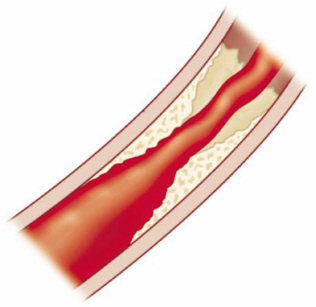 Cholesterol is a type of fat which occurs naturally in the body. It has both good and bad effects on the body. The body uses cholesterol to make hormones and to build and maintain nerve cells. However, when the body has too much cholesterol deposits of fat called plaques form inside blood vessel walls. The blood vessel walls thicken and the vessels become narrower. This change in the blood vessels reduces blood flow through the blood vessels contributing to heart attacks and strokes.
Cholesterol is a type of fat which occurs naturally in the body. It has both good and bad effects on the body. The body uses cholesterol to make hormones and to build and maintain nerve cells. However, when the body has too much cholesterol deposits of fat called plaques form inside blood vessel walls. The blood vessel walls thicken and the vessels become narrower. This change in the blood vessels reduces blood flow through the blood vessels contributing to heart attacks and strokes.
Types of Cholesterol:
Cholesterol travels through the blood attached to a protein. This cholesterol-protein package is called a lipoprotein. Lipoproteins are classified as high density, low density, or very low density, depending on how much protein there is in relation to fat.
- Low density lipoproteins (LDL): LDL, also called “bad” cholesterol, can cause buildup of plaque on the walls of arteries. The more LDL there is in the blood, the greater the risk of heart disease.
- High density lipoproteins (HDL): HDL, also called “good” cholesterol, helps the body get rid of bad cholesterol in the blood. The higher the level of HDL cholesterol, the better. If your levels of HDL are low, your risk of heart disease increases.
- Very low density lipoproteins (VLDL): VLDL is similar to LDL cholesterol in that it contains mostly fat and not much protein.
- Triglycerides: Triglycerides are another type of fat that is carried in the blood by very low density lipoproteins.
Diet guidelines to help control your cholesterol:
- Check labels for fat and cholesterol content.
- Eat fruits and vegetables, beans, and whole grains daily. The fiber in these foods helps lower cholesterol.
- Reduce the amount of cholesterol in your diet.
- Eat less fat. Limit the amount of butter and margarine you eat.
- Use sunflower, safflower, soybean, canola, corn, or olive oil.
- Use egg whites or egg substitutes rather than whole eggs.
- Replace whole-milk dairy products with nonfat or low-fat milk, cheese, spreads.
- Eat skinless chicken, turkey, and fish more often than red meat.
- Choose lean cuts of meat; trim off all visible fat.
- Avoid fatty desserts: ice cream, cream-filled cakes, and cheesecakes.
- Reduce amount of fried foods and fast foods.
Where does cholesterol come from?
Cholesterol comes from 2 sources — most are synthesized by the liver. Major dietary sources of cholesterol include animal products, meat, egg yolks, cheese, fish, and shrimp.
How is cholesterol measured?
It is measured by a blood test called fasting lipid profile. A total cholesterol of less than 200 mg/dl is considered good.
What is the target LDL goal?
The goal is less than 160 mg/dl if your risk of heart disease is low, less than 130 mg/dl if you have a moderate risk, or less than 100 mg/dl if you’re a high risk of heart disease or diabetes.
How can seniors control cholesterol?
Eating right and exercising can usually control cholesterol levels. If you have a high risk for heart disease, your health care provider may prescribe cholesterol lowering medications as well as changes in lifestyle. Statin drugs such as Lipitor, Crestor, Zocor, Pravachol, Mevacor, all lower LDL cholesterol. Niacin, a B vitamin, increases HDL cholesterol.


Leave a Reply